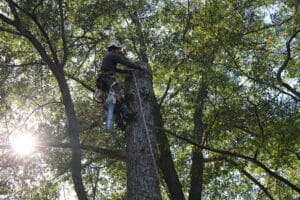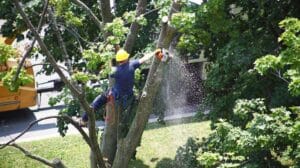Trimming a palm tree is a vital aspect of its overall maintenance, ensuring the tree remains healthy, safe, and visually appealing. Whether you’re a novice gardener or a seasoned enthusiast, this comprehensive guide will walk you through the essential steps of trimming a palm tree, using NLP terms and LSI keywords for easy comprehension.
Steps to Trim a Palm Tree
Step 1: Determine the Health of the Palm Tree
Before you pick up your pruning tools, it’s crucial to assess the health of your palm tree. Pruning should primarily occur when fronds (leaves) are dead or broken or when the tree starts to produce flowers or bear fruit. Pay attention to the following indicators:
- Palm Flowers and Fruit Stalks: Observe if your palm tree has flower stalks or fruit. These consume energy and can hinder the tree’s growth. If present, trimming is necessary to redirect the tree’s resources for better development.
- Overall Health Evaluation: Check for signs of decay, disease, or pest infestation. Healthy fronds should be green and vibrant. If you notice brown, yellow, or wilting leaves, your palm may need some attention.
Remember, avoid unnecessary trimming, as over-pruning can weaken the tree and leave it susceptible to further damage.
Step 2: Select Appropriate Equipment
Having the right tools for the job is crucial for effective palm tree trimming. Consider the size of your tree to determine the most suitable equipment. Standard tools include pruners, loppers, and pole saws.
- Pruners: Pruners are ideal for trimming small, young palms. They provide precision cutting for removing dead or small fronds.
- Loppers: For more enormous palms, loppers are essential. These long-handled tools offer better leverage to trim thicker fronds or branches.
- Pole Saws: If your palm tree is tall, a pole saw will enable you to reach higher fronds without the need for a ladder.
Ensure your equipment is sterile and sharp to avoid causing unnecessary damage to the tree during the trimming process.
Step 3: Remove Dead or Broken Fronds
Now that you’ve assessed the health of your palm and have the appropriate tools, it’s time to start trimming:
- Positioning for Trimming: Stand safely on the ground, using a ladder only if necessary. Avoid walking on fronds as they can be slippery and unstable.
- Trimming Technique: Use your pruners or loppers to cut dead or broken fronds at least 2 inches away from the trunk. This prevents damage to the tree and reduces the risk of introducing pests and diseases.
Step 4: Remove Fruit, Seeds, and Flowers
Timing is essential when it comes to palm tree trimming. Ideally, wait until spring to perform any pruning. Avoid pruning for purely cosmetic reasons, as this may harm the tree and disrupt its natural growth patterns.
- Different Trimming Patterns and the 9-3 Rule: To ensure proper trimming, follow the 9-3 rule. This means avoiding the removal of fronds growing at the 9 o’clock and 3 o’clock positions on the trunk. These fronds play a crucial role in the tree’s overall health and support its growth.
Frequently Asked Questions
What is the best time of year to trim a palm tree?
The best time of year to trim a palm tree is during the spring season. Spring is the period when palm trees experience active growth and recovery from any potential stress caused by colder months. Trimming during this time allows the palm to heal quickly and utilize its resources efficiently for new frond development.
How do you identify which fronds to trim on a palm tree?
Identifying which fronds to trim on a palm tree requires a careful assessment of the tree’s health. Follow these guidelines to determine which fronds to trim:
Look for Dead or Broken Fronds: Dead or broken fronds are easily recognizable. They are brown, dry, and show no signs of life. These fronds should be the first to be trimmed.
Check for Flowers and Fruit Stalks: Palm trees use a significant amount of energy to produce flowers and fruits. If your palm has these, consider trimming them to redirect the tree’s resources for better growth.
Follow the 9-3 Rule: Avoid removing fronds that are growing at the 9 o’clock and 3 o’clock positions on the trunk. These fronds are crucial for the tree’s health and growth.
What are some common mistakes to avoid when trimming a palm tree?
Avoiding these common mistakes can help ensure successful palm tree trimming:
Overpruning: Pruning too many fronds can weaken the tree and lead to slower growth or even palm stress.
Trimming Green Fronds: Green fronds are healthy and actively contribute to the palm’s growth. Cutting them prematurely can harm the tree.
Using Dull or Unclean Tools: Using blunt or dirty equipment can cause jagged cuts and introduce diseases to the tree.
Removing Too Many Flowers or Fruits: While trimming flowers and fruits can be beneficial, removing all of them can harm the tree’s reproductive cycle.
What is the best way to trim palm trees?
The best way to trim palm trees is by following these steps:
Assess the Tree: Determine if your palm tree requires trimming based on dead or broken fronds, flowers, or fruits.
Choose the Right Time: Trim during the spring when the tree is actively growing and can heal faster.
Select the Appropriate Tools: Use clean and sharp pruning equipment suitable for the size of your palm tree.
Follow the 9-3 Rule: Avoid removing fronds growing at the 9 o’clock and 3 o’clock positions to maintain tree health.
Proper Cutting Technique: Cut fronds at least 2 inches away from the trunk to prevent damage.
What is the best tool to trim palm trees?
The best tool to trim palm trees depends on the size and height of the tree:
Pruners: Ideal for small palms and precision trimming of smaller fronds.
Loppers: Suitable for more enormous palms with thicker fronds or branches.
Pole Saws: Perfect for tall palms, allowing you to reach higher fronds without a ladder.
Remember to ensure the tools are sterile and sharp to avoid injuring the palm tree during the trimming process.
Conclusion
Trimming a palm tree is an essential practice to maintain its health and appearance. By following the steps outlined in this guide, you can ensure effective and responsible palm tree trimming. Remember to assess the tree’s health, use appropriate equipment, and avoid over-pruning. By adhering to these guidelines, you can keep your palm tree flourishing for years to come. Happy trimming.





